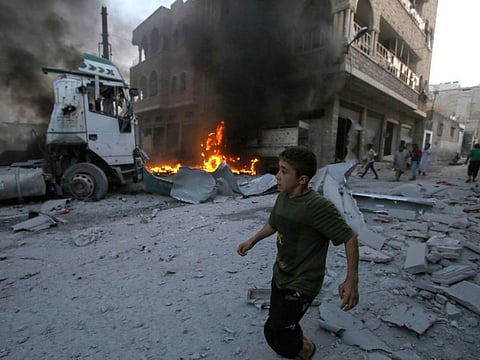With eye on safe zone, Erdogan gambles with Idlib’s fate
Time and time again he has abandoned Syrian rebels to get concessions from Russia

Damascus: Nearly ten days after a Turkish convoy was attacked in Syria, no military response has come out of Ankara, raising speculation that an undercover deal is being hammered out on Idlib between Ankara and Moscow, to set up a highly-coveted safe zone that protects Turkey’s borders from Kurdish forces.
Turkey has a volatile relationship with its sizable Kurdish population and fears a rebellion from within.
Therefore, it has a vested interest in weakening armed Kurdish groups in Syria and Iraq as to keep their aspirations for independence at bay.
In mid-August, a Turkish convoy rumbled through the Syrian desert, heading for the city of Idlib in the Syrian northwest.
Hopes were raised among the armed Syrian opposition, who mistakenly believed that the convoy was coming to fight on their side and save them from a joint Syrian-Russian assault that started in April.
The convoy was bombed by the Syrians on August 19 and its advance was halted.
Turkish officials were quick to put out the message that the convoy’s objective had no intention of confronting the Syrian army.
That same day the rebel-held town of Khan Sheikhoun was re-taken by the Russian-backed Syrian army after being in rebel hands since mid-2015.
The Syrian opposition slammed Turkish President Recep Tayyip Erdogan for selling them out to the Russians.
But, this is not the first time Turkey has exploited the Syrian opposition movement to get what it wants.
The Turkish leader had done it before, after all, abandoning his proxies in east Aleppo, back in 2016, in return for getting a green light to march on the Kurdish-held border cities of Jarablus and Azaz.
He did it again in 2018, when he turned a blind eye to the re-take of the Damascus suburb of East Ghouta in exchange for sending his proxies to overrun the city of Afrin.
On August 27, Erdogan landed in Moscow for a meeting with Putin.
Both presidents expressed “grave concern” over what was happening in Idlib.
“An agreement is being made by Turkey on Idlib, with Russia, rather than the United States,” stressed Cahit Delik, president of the 21st Century Turkey Institute. “The two parties will try to resolve the current crisis, not by ending it but rather, by postponing it.”
Speaking to Gulf News, he explained: “Turkey will be obliged to abandon three of the observation points that it set up in Idlib via the Astana Process; point 9 in Morek (Hama district) and the ones numbered 8 and 10, set in the south of Idlib. They will all be transferred to Russian control within the next 1-2 months.”
In February, Erdogan received an offer from Russian President Vladimir Putin, calling for revival of the 1998 Adana Agreement between Syria and Turkey.
It effectively creates a safe zone for Turkey, only without calling it a safe zone.
The Adana text prevents Kurdish militias from setting up base in Syria and gives the Turks the right to enter Syrian territory as far as 5-km in pursuit of Kurdish militants, after obtaining permission from Syrian authorities.
It was originally drawn up to end Syrian support for the Kurdistan Workers Party and its leader, Abdullah Ocalan.
Putin said the Adana agreement would give the two countries a legal pretext to talk, which would mean de facto Turkish recognition of the Syrian government.
If Erdogan did not trust the Syrian Army on his borders, Putin offered to deploy Russian troops along the border area instead, to make sure that they remain free of any Kurdish presence.
Erdogan unhappy with US offer
While the US is also in talks with Erdogan on the creation of a safe zone, it seems that Turkey is not currently happy with what they have offered him.
Earlier this month, Erdogan realised that he was not going to get the safe zone that he envisioned — a zone 460 km in width, stretching from Jarablus in Syria to Faysh Khabour on the Tigris River, and 32 km in depth.
He would use this zone to relocate thousands of Syrian refugees who have been living in Turkey since 2011, after clearing it from any Kurdish presence.
What he got instead were “military arrangements” with the Americans “which fall short of being called clearly defined safe zone” according to Ebraheem Hamidi, a prominent Syrian journalist from Idlib.
“Washington expressed readiness for a zone that was only 14-15 km in depth and no more than 100 km in width,” he told Gulf News.
The Americans also agreed to push Kurdish militants from the People’s Protection Units (YPG) away from the border area, with their heavy weapons, into a depth of 20 km, but made it clear that he could not cross into Syria to hunt them down.
This week the YPG began withdrawing from border posts in Ras Al Ain and Tal Abyad, two Kurdish towns that have been on Erdogan’s hitlist since last December.
The Americans also offered to run joint patrols between the US and Turkish armies, to monitor the possible re-emergence of Daesh, rather than to assign the task to Kurdish militias.
Speaking to CNN Turk on Thursday, Erdogan called on the Americans not to stall the safe zone.
“We will never tolerate delay,” he said, adding: “The process must advance rapidly.”
Sign up for the Daily Briefing
Get the latest news and updates straight to your inbox



